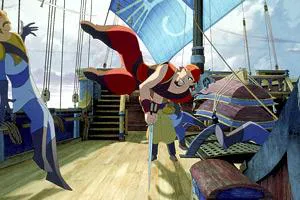The summer Hollywood cartoon “Sinbad: Legend of the Seven Seas” has absolutely nothing to do with “One Thousand and One Nights,” except for the name and profession of the main character. Does this mean it’s bad or harmful? Not at all. It’s just that, despite being aimed at teenagers, it will only be enjoyable for those who have actually read “One Thousand and One Nights.” And, at the same time, have at least skimmed the Greek myths in their textbooks. There’s no doubt they’re familiar with Hollywood, which is also useful. Under these conditions, “Sinbad: Legend of the Seven Seas” becomes a fairly fresh, pleasant parody of how Hollywood views everyone who isn’t from there.
A Hollywood Take on Ancient Tales

Old World history, in general, looks completely American, in the spirit of “Dumb and Dumber,” when they joked that Abraham Lincoln was the communist who killed Godzilla with penicillin. Sinbad is like an ancient Arab gangster, stealing small things but running when a big gangster appears. And if he meets a drug lord, he immediately stands at attention. The role of the drug lord is taken by the ancient Greek goddess of chaos, Eris, who is after the same trinket as Sinbad: the Syracusan Book of Peace. He promised her this thing in a nightmare. But Syracuse is like the White House, which won’t tolerate outside interference, and there’s nothing for a small-time gangster to gain there. But he has connections in the Oval Office itself, and he can pull strings to make them all fight, and then quickly become a big shot, relaxing in a hammock on the Fiji Islands. And almost everything worked out, Fiji (the Canaries, Hawaii, the Bahamas) was within reach, if it weren’t for the fact that Sinbad’s childhood friend, who also happened to be the son of the Syracusan despot, had a beautiful bride. How could he not steal her away if she led him on? And Sinbad sailed with this Marina to a place he didn’t intend to go, namely to the end of the world, the next stop being Tartarus, where Eris is keeping the stolen book for some reason.

A Hilarious Mashup of Myths and Movies
The whole fun of the commotion is how brazenly the Greeks, Arabs, Romans, and medieval mythology are mixed up with each other and with American B-movies. The more brazen, the more fun, because the parody is more targeted. How would a modern-day small-time project manager from Beverly Hills tell a child a bedtime story about ancient history? About the same way our guy in a suit with a swagger, who owns a gas station in Lyubertsy, would do it. Our child would hear how “some broad came at me for no reason, a goddess, like, we set up a meeting, like, between Sicily – no, not Sicily – there was another one, and the goddess, like, sent some hookers instead of herself, like, Sirens, Sirens – a cool chanson, the boys don’t bother messing with their signs, and then the talk started…”

In Beverly Hills, the meaning is the same, only with a bunch of security at social events in Syracuse, the despot’s son saying things like “Let’s go, I’ll introduce you to someone. - Is it me?”, and Sinbad himself looking like the popular hero Gladiator, that is, Russell Crowe. Crowe was actually supposed to dub him, but he refused, and they took Brad Pitt, but the resemblance remained, as did the manners from the streets. Such adaptations are hugely valuable, because antiquity remains antiquity, only entertaining for those with a swagger, which is comical for everyone else. One of our screenwriters from the “counterintelligence” survived in a camp in the late 30s by adapting “The Three Musketeers” and “Manon Lescaut” into thieves’ slang for the inmates before bedtime.

The Creative Force Behind the Parody
The merit of this parody belongs to the screenwriter of the cartoon, John Logan. A serious guy, he’s also behind “The Last Samurai” (2003), “Gladiator” (2000), and even “RKO 281” (1999) – a sarcastic swipe at the history of Hollywood when “Citizen Kane” was being filmed. That is, Logan knows the manners of Beverly Hills like the back of his hand, and he put the maximum of this poisonous knowledge into Sinbad, the Syracusans, and the Greek gods. And the voices of the real Brad Pitt, Michelle Pfeiffer, Catherine Zeta-Jones, and Joseph Fiennes, which are unfortunately inaudible in our dubbing, must have complemented it well. In any case, all foreign viewers highly praise the original voice acting.

Visuals and Animation Style
In terms of computer special effects, the image of “Sinbad: Legend of the Seven Seas” lags far behind the benchmark “Shrek.” But it decided to take a different approach, and everything is in the same logic. If the history of the Ancient World is viewed through Hollywood, then the world itself is viewed purely through cinema. The cartoon uses such an old, reliable cinematic technique as a sharp angle. Almost all the way, it’s not frontal shots with some million-strong crowd that hit the eye, but angled shots: from a wave, from a ship’s yardarm, from under a stone, from a block under an ax. All this, of course, is also drawn on a computer, but it looks dynamic and almost interactive. It’s as if you’re breathless from the first fight with the octopus, from the race with the whale-island-surfer, from the big white bird in the ice, from the very Edge of the World and the next Tartarus. Look: there are purely philosophical, curious things there. That’s exactly how we all imagined the Edge of the World in childhood.

In general, it must be said that the drawing itself (directors Tim Johnson and Patrick Gilmore) is primitive to the extreme. Both Sinbad, his sailors, Marina, Eris, the prince, and even the ship’s bulldog are made in three strokes plus a colored blob. But again, in the logic of parody, just a minimum of means can give the maximum accuracy of one specific action, recognition, or emotion.
And there’s a lot of action in the cartoon. It’s not exactly a masterpiece, but there’s somewhere to look before the end of the holidays.